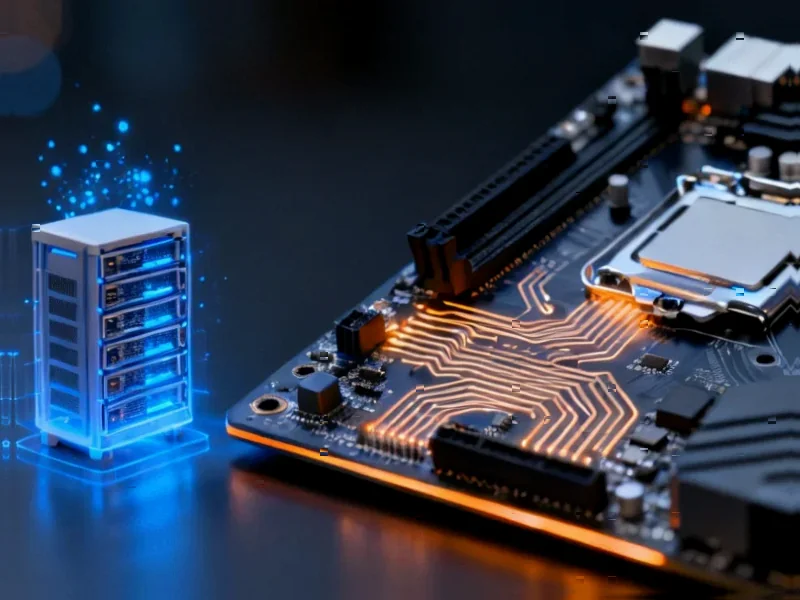According to Financial Times News, KKR’s global head of digital infrastructure argues that AI is at a similar turning point as early electrification, with Wall Street estimates showing AI hyperscalers expected to more than double their 2022 data center capital expenditure by 2025. AI-related capex now accounts for about 5% of US GDP and is growing roughly 10% annually, with Bain forecasting 200GW of AI-driven extra power capacity needed globally by 2030. The analysis draws parallels to historical infrastructure booms where many individual companies failed but the underlying infrastructure endured, noting that even a 1 cent per kWh power cost difference translates to $18 billion annually across the forecasted capacity. This perspective suggests investors should focus on infrastructure elements that resist commoditization rather than chasing “bragawatts” in data center announcements.
The Physics of Power Economics
The power consumption numbers being discussed represent unprecedented demands on global energy infrastructure. When we talk about 200GW of additional capacity by 2030, we’re essentially discussing the equivalent of adding 200 large nuclear reactors worth of dedicated power generation. What makes this particularly challenging is that AI workloads aren’t flexible – they can’t be easily shifted to off-peak hours or curtailed during grid stress. The computational intensity of training and inference operations means power availability becomes the primary constraint on AI scaling, not just a cost consideration.
The Real Infrastructure Bottlenecks
While much attention focuses on GPU availability and data center construction, the true bottlenecks are in power delivery systems and regulatory approvals. Grid interconnection queues in many regions now stretch for years, with projects facing multi-year delays simply to connect to transmission networks. The complex process of grid interconnection studies involves detailed analysis of how new loads will affect voltage stability, thermal limits, and system protection schemes. Meanwhile, land acquisition near adequate power infrastructure has become increasingly competitive, with prime locations commanding premium prices that smaller players cannot afford.
Technical Architecture Implications
The power density requirements of AI infrastructure are driving fundamental changes in data center design. Traditional data centers operated at 5-10 kW per rack, but AI workloads are pushing this to 40-60 kW and beyond. This necessitates liquid cooling technologies that can handle heat loads an order of magnitude higher than air cooling can manage. The shift also requires rethinking power distribution architecture, with higher voltage DC power distribution gaining traction to reduce conversion losses. These technical requirements create significant barriers to entry and favor operators with deep engineering expertise and capital reserves.
Where Smart Money Differentiates
Sophisticated infrastructure investors are looking beyond simple capacity metrics to focus on structural advantages in power procurement. The most valuable positions combine long-term fixed-price power contracts with strategic grid interconnection rights and scalable land positions. According to EIA data on electricity markets, regions with diverse generation mixes and competitive wholesale markets offer better long-term pricing stability. The winners will be those who secured positions in markets with underutilized transmission capacity and supportive regulatory environments for data center development.
The Sustainability Challenge
The massive energy demands of AI infrastructure are colliding with climate commitments and ESG considerations. While some operators are pursuing renewable energy procurement through power purchase agreements (PPAs), the intermittent nature of solar and wind creates matching challenges with 24/7 AI operations. This is driving interest in advanced nuclear, geothermal, and other firm power sources that can provide carbon-free baseload power. The infrastructure players who solve this sustainability-power reliability equation will command premium valuations as corporate AI customers increasingly demand clean energy solutions.
The Coming Shakeout Strategy
History suggests that while the underlying AI infrastructure will endure, many individual operators will not survive the coming consolidation. The dot-com fiber optic boom saw numerous bankruptcies, but the installed capacity became the foundation for decades of internet growth. The survivors in AI infrastructure will be those who control scarce resources – particularly strategic power positions and interconnection rights – rather than those who simply built the most capacity. As the industry matures, we’re likely to see a bifurcation between commodity colocation providers and specialized AI infrastructure operators with structural advantages in power economics and technical capabilities.




